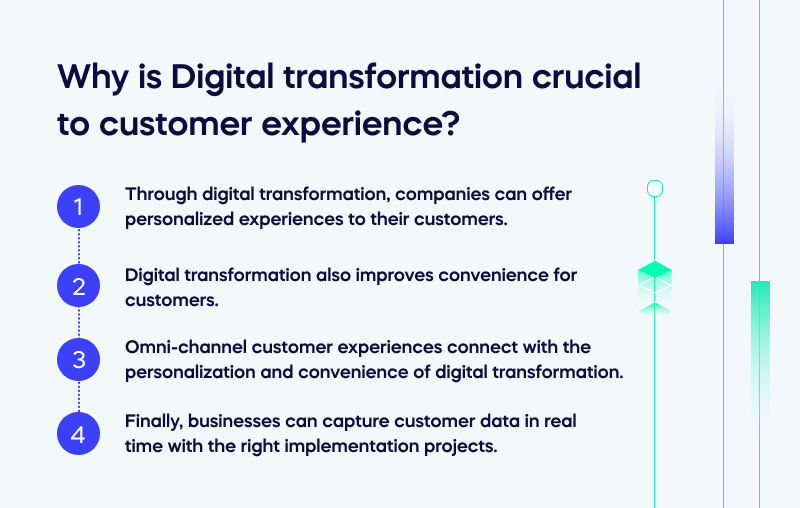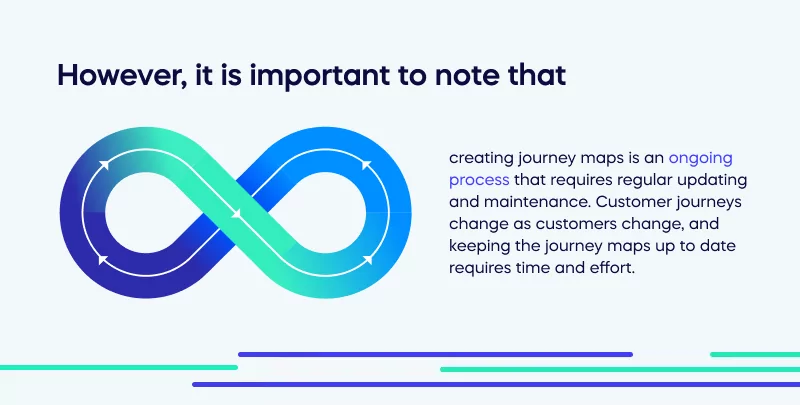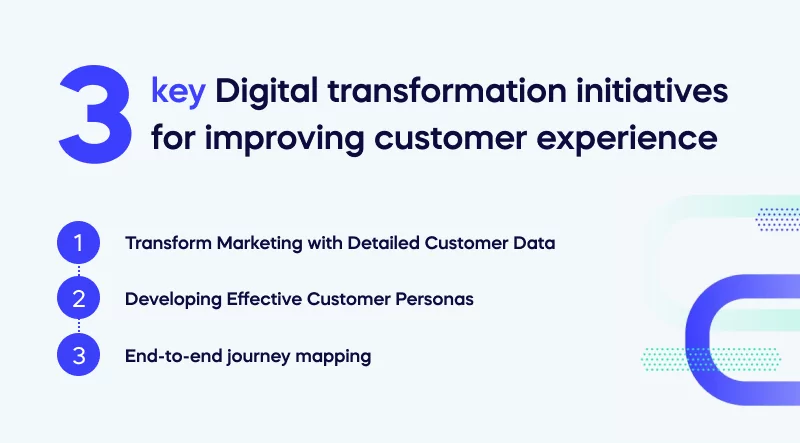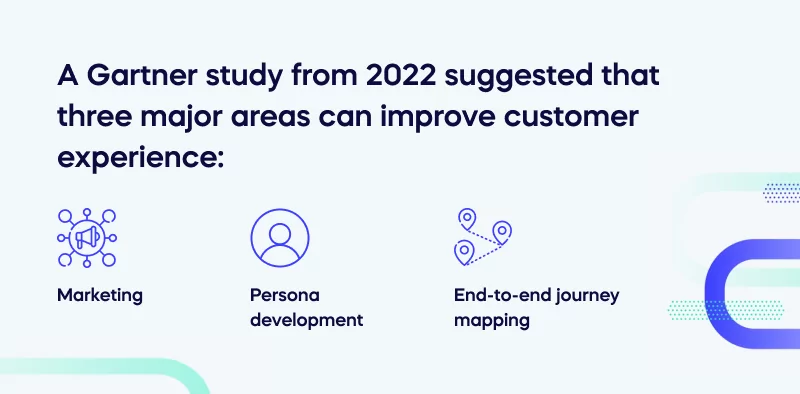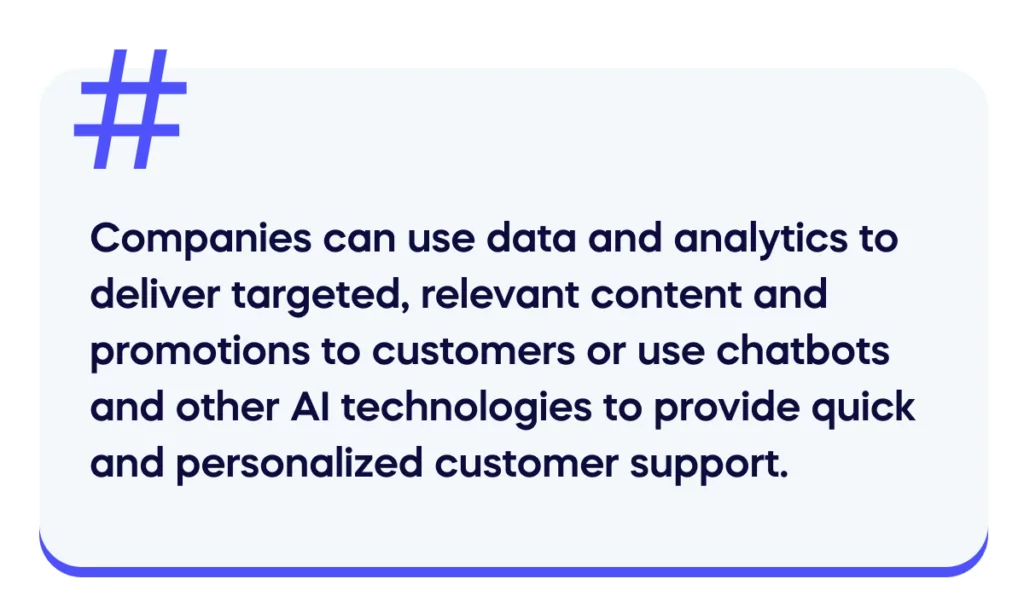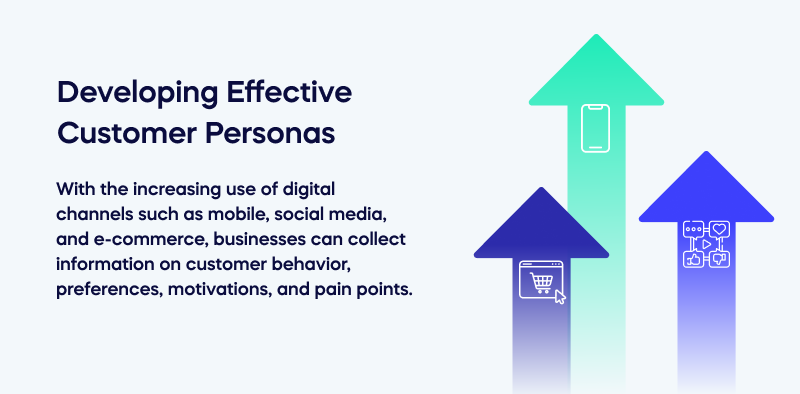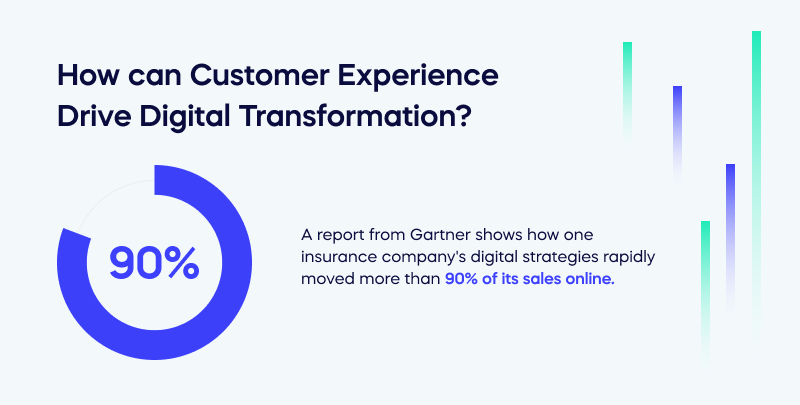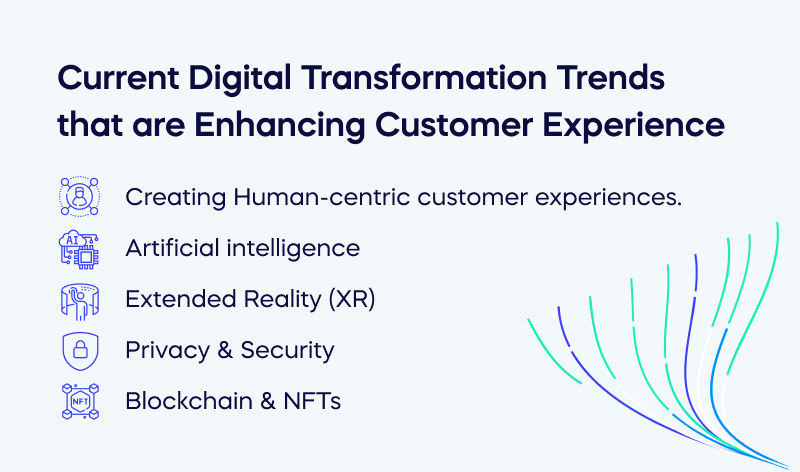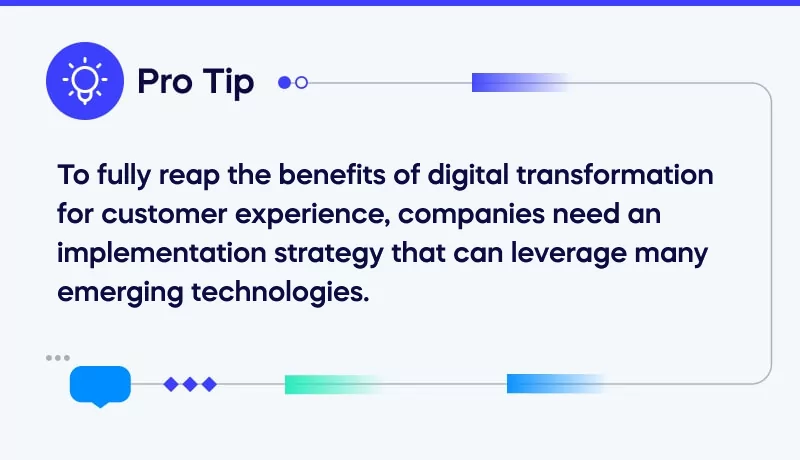In a successful digital transformation, customer experience (CX) is one of the most critical areas to get right. Using digital transformation to improve customer experience makes life better for clients. But it also creates valuable data that can be used across the company.
As we know, digital transformation should involve every part of a business. Business processes are digitally transformed when they use automated digital systems to make their work more efficient, reliable, and user-friendly.
The role of digital transformation in customer experiences can take many forms. Many of a company’s digital strategies will be completely hidden from customers. In other cases, the entire customer journey itself will be digitally transformed with brand-new interfaces and functions.
In today’s digital world, technology is the main way that customer experience can be improved in the 2020s. Future-ready businesses should think about changing their customer experiences into digital customer experiences. To help with this effort, this article will explain some of the key features of digital transformation for customer experience front liners and customer service leaders.
The article will start by explaining how digital transformation connects with customer experience. It will then show how customer expectations may drive digital change itself. Customers now have clear expectations of businesses working with digital means: such as a digital-first buying journey, personalized marketing, and accessible customer services.
Finally, we will look at three key ways digital transformation can impact overall business processes: improved marketing, more accurate personas, and journey mapping.
What is digital transformation in customer experience?
Businesses use digital transformation in customer experience to enhance the relationship between both parties. It usually involves digital tools and channels to provide customers with more convenient, efficient, and personalized experiences.
Strategies to digitally improve customer service can include:
-
Chatbots and automated support systems
-
Self-service online portals
-
Personalizing interactions with data analytics
-
Engaging with customers through social media and other digital channels.
Digital transformation can take customer experience to a whole new level.
Why is Digital Transformation Important In Customer experience?
Digital transformation initiatives are an essential driver of convenience and personalization, the most critical areas of customer experience. New technologies also help to empower customers with omnichannel experiences. Furthermore, digital solutions help leaders and employees to make well-informed business decisions that benefit customers in real-time.
Through digital transformation, companies can offer personalized experiences to their customers. Artificial Intelligence processes can take a customer’s purchase history, browsing, and interactions to provide the most suitable product recommendations, content, and communications. AI is not a perfect science, but these processes can improve customer interactions, supporting them to make further purchases.
Digital transformation also improves convenience for customers. Some businesses offer complex services to their customers, whether large-scale B2B vendors or personal banking. Mobile apps can help customers keep track of their relationship with the company. Businesses no longer need a large bank of customer service employees to ensure customer satisfaction. Digital technology offers solutions that are more reliable and clearer.
Omni-channel customer experiences connect with the personalization and convenience of digital transformation. Traditionally, different communication channels would not be linked. Sales, customer service, and general operations would not share the same information.
Now, digital transformation enables organizations to integrate their various channels and touchpoints, such as online, in-store, mobile, and social media. This creates a consistent and seamless experience for customers, who can switch between channels without interruption.
Finally, businesses can capture customer data in real time with the right implementation projects. Automation and customer journey mapping enable companies to touch customer engagement points, resulting in faster customer service responses, enhanced customer communication systems, improved cross-selling efforts, and better customer segmentation.
It’s not enough to create a patchwork of legacy systems, fashionable technology, and “quick fixes” that please customers. A fully functioning digital customer experience requires root-and-branch digital transformation projects.
How can Customer Experience Drive Digital Transformation?
In the past, customers found it strange and new to use digital technologies to interact with a company. But today, digital transformation projects are driven by customer demands for convenience, consistency, and service availability across all sectors.
As customers are ready for digital services, digital transformation projects can bring about excellent results in customer experience. A report from Gartner shows how one insurance company’s digital strategies rapidly moved more than 90% of its sales online. Results like this show that future-facing companies must understand that they will not survive with a customer experience based on the past.
Companies investing in digital transformation for customer experience will spend less on older marketing and engagement forms. For many businesses, highly targeted content marketing on social media is better than cold calls or mail shots.
A comprehensive knowledge base optimized for search engines is better than outdoor advertising. And customer support through searchable FAQs, online messaging, and chatbots do much more work than a single telephone-based support center.
For all these reasons, customer demands can drive companies to take up digital transformation projects. Companies should be proactively working to improve customer experiences with digital transformation and find the business benefits they bring.
Three key Digital transformation initiatives for improving Customer Experience
A Gartner study from 2022 suggested that three major areas can improve customer experience: Marketing, persona development, and end-to-end journey mapping.
These areas prove that digital transformation in customer experience is a strategic mindset shift. Leaders must seek wide-ranging changes and major improvements when making digital changes. Even when business leaders want to focus on one area for improvement, digital transformation projects should work in harmony with other business areas.
Transform Marketing with Detailed Customer Data
Digital transformation in customer experience can improve a company’s marketing work by allowing marketers to better understand and address customers’ needs throughout their journey, not just at the point of purchase.
This shift in focus from acquisition to post-acquisition experience can significantly impact marketing efforts, as it provides a more comprehensive view of the customer’s interactions with the company.
By including the post-acquisition stages in the customer journey map, marketers can identify areas where customer experience can be improved, leading to increased satisfaction, loyalty, and advocacy. This, in turn, can drive repeat business, positive word-of-mouth, and increased brand reputation.
Digital technologies also provide new opportunities for personalization and engagement, which can help companies differentiate their brand and increase customer loyalty. For example, companies can use data and analytics to deliver targeted, relevant content and promotions to customers or use chatbots and other AI technologies to provide quick and personalized customer support.
Developing Effective Customer Personas
Digital transformation solutions allow businesses to gather, analyze and utilize vast amounts of customer data to create compelling customer personas.
With the increasing use of digital channels such as mobile, social media, and e-commerce, businesses can collect information on customer behavior, preferences, motivations, and pain points. This data can help create accurate customer personas that represent specific customer base segments when analyzed and organized.
By deeply understanding their customer personas, businesses can tailor their marketing efforts, product offerings, and customer experience to meet the needs and wants of their target audience. This results in a more personalized and practical approach, increasing customer satisfaction and loyalty.
End-to-end journey mapping
Organizations can improve cross-functional collaboration and customer experience success by developing end-to-end journey maps through digital transformation.
However, it is important to note that creating journey maps is an ongoing process that requires regular updating and maintenance. Customer journeys change as customers change, and keeping the journey maps up to date requires time and effort.
Digital transformation can play a key role in streamlining the end-to-end journey mapping process by providing access to a wealth of customer data and analytics.
This data can be used to gain a deeper understanding of the customer journey, identify areas of improvement and optimize the journey accordingly.
By leveraging digital technologies, organizations can gather data from multiple touchpoints and channels, such as mobile, social media, and e-commerce, to create a comprehensive and accurate representation of the customer journey.
Digital Transformation Trends in Customer Experience
Digital transformation can impact an organization in many ways. In this section, we will take a look at four key priority areas for customer experience in 2023: creating excellent experiences; leveraging AI to its maximum capacity; the advent of extended reality; and data security.
Each of these four areas involve a different part of the CX ecosystem. There’s a reason for this. Creating great customer experiences with DX means a wide-ranging implementation of digital tools. As time goes by, it will be more important than ever to invest in all these areas!
Creating Consistently Excellent Experiences
Digital solutions are fantastic for consistency.
For example, users don’t need to tell customer support the same information over and again – it can be stored in one central location. And they can be assured of getting the same level of customer care whenever they decide to shop online.
Digital systems consistently adapt to different users. With the right applications, companies can do a lot more for elderly and differently-abled people.
Artificial intelligence
Artificial intelligence (AI) is already playing a significant role in the customer experience, from personalized product recommendations to chatbots that handle basic customer service inquiries.
AI will become even more impactful in the coming years, with applications ranging from voice-activated shopping to predictive analytics anticipating customer needs and wants.
Extended Reality (XR)
Using Extended Reality (XR) to augment customer experience. Extended reality (XR), which includes both augmented reality (AR) and virtual reality (VR), is becoming an increasingly important tool for retailers looking to enhance the customer experience.
XR allows customers to “try before they buy,” whether that means test-driving a car in VR or seeing how a piece of clothing looks on them in AR. By providing these types of interactive experiences, retailers can create a more engaging and memorable shopping journey for their customers.
Data Security and Digital Trust
Data breaches are one of the most serious problems a modern company can face.
More emphasis on privacy and security. As customers become more comfortable submitting their personal information online, companies must prioritize privacy and security to build trust with their customers.
Any customer-facing company should take responsibility for customer data and digital security. This means investing in robust security systems and protocols and transparently communicating with customers about how their data is being used and protected.
Enhancing Customer Experience With Digital Transformation
The digital transformation journey is fundamental for better customer experiences. Technology helps companies to provide personalized, convenient and connected customer experience transformation through omnichannel integration and real-time customer data capture.
Business models that help businesses exceed customer expectations are being developed on blockchain and NFTs. As these technologies continue to evolve, companies should consider incorporating them into their strategies to remain competitive and deliver outstanding customer experiences.
Companies are now recognizing the criticality of customer satisfaction in driving digital transformation projects. Unifying digital transformation and customer fulfillment is essential for progress; you will likely experience improved consumer experiences, and your marketing costs may also be reduced.
Nevertheless, to guarantee that a successful digitized customer journey is achieved, organizations must undertake an extensive overhaul – merely cobbling together technology solutions will prove futile.
To fully reap the benefits of digital transformation for customer experience, companies need an implementation strategy that can leverage many emerging technologies.


